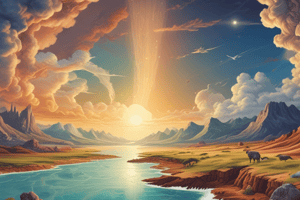Podcast
Questions and Answers
What type of plate boundary is formed when two plates slide past each other?
What type of plate boundary is formed when two plates slide past each other?
- Divergent Boundary
- Subduction Zone
- Transform Fault Boundary (correct)
- Convergent Boundary
A divergent boundary is characterized by plates colliding.
A divergent boundary is characterized by plates colliding.
False (B)
Name one geological feature that can result from a convergent plate boundary.
Name one geological feature that can result from a convergent plate boundary.
mountains
Transform faults are associated with ______ and earthquakes.
Transform faults are associated with ______ and earthquakes.
Match the following plate boundaries to their characteristics:
Match the following plate boundaries to their characteristics:
What is the primary characteristic of a divergent boundary?
What is the primary characteristic of a divergent boundary?
All geological events occur equally in all areas of the lithosphere.
All geological events occur equally in all areas of the lithosphere.
Name one geological feature typically found at a convergent plate boundary.
Name one geological feature typically found at a convergent plate boundary.
At transform fault boundaries, tectonic plates move ______ each other.
At transform fault boundaries, tectonic plates move ______ each other.
Match the following types of plate boundaries with their actions:
Match the following types of plate boundaries with their actions:
Which statement about plate boundaries is true?
Which statement about plate boundaries is true?
What causes tectonic plates to move?
What causes tectonic plates to move?
Volcanoes are not influenced by plate tectonics.
Volcanoes are not influenced by plate tectonics.
What geologic feature is formed on top of the continental leading plate during the collision of an oceanic and continental plate?
What geologic feature is formed on top of the continental leading plate during the collision of an oceanic and continental plate?
The process of subduction occurs when two continental plates collide.
The process of subduction occurs when two continental plates collide.
What is formed in the ocean as a result of subduction?
What is formed in the ocean as a result of subduction?
The ___________ is the deepest part of the ocean formed at subduction zones.
The ___________ is the deepest part of the ocean formed at subduction zones.
Match the geological features with their descriptions:
Match the geological features with their descriptions:
What percentage of the total energy released by earthquakes comes from shallow earthquakes?
What percentage of the total energy released by earthquakes comes from shallow earthquakes?
Volcanic activity has no relation to the presence of water in magma.
Volcanic activity has no relation to the presence of water in magma.
What occurs due to the continuous grinding of tectonic plates?
What occurs due to the continuous grinding of tectonic plates?
Flashcards are hidden until you start studying
Study Notes
Plate Interactions and Geological Features
- Volcanic arcs form at the collision of oceanic and continental plates due to the subduction of the denser oceanic crust.
- Subduction involves the bending of the oceanic crust into the mantle, where it melts forming magma.
- Addition of water and other volatiles to magma reduces its density, allowing it to rise, causing volcanic activity on the continental crust.
Ocean Trench Formation
- Ocean trenches, the deepest parts of the ocean, are created at subduction zones.
- The Philippine Trench is one of the deepest ocean trenches, reaching 10,540 meters in depth.
Earthquake Generation
- Continuous grinding of tectonic plates can lead to earthquakes of varying depths.
- Shallow earthquakes, occurring within 60 km of the Earth's surface, account for 85% of the total energy released by earthquakes.
Plate Tectonics Model
- Earth's lithosphere is segmented into numerous tectonic plates that are in constant motion.
- Three main types of plate boundaries are identified: Divergent, Convergent, and Transform.
- Divergent boundaries occur when plates move apart; convergent boundaries occur when plates collide; transform boundaries feature plates sliding past one another.
Importance of Plate Boundaries
- The boundaries of lithospheric plates are characterized by significant geological events, including earthquakes, mountain ranges, and volcanism.
- Studying these boundaries is crucial since they drive lithospheric deformation, impacting both the environment and human activity.
Summary of Plate Motion
- The motion of tectonic plates relative to each other leads to the formation of different geologic features and events, marking locations of high seismic activity and volcanic eruptions.
Studying That Suits You
Use AI to generate personalized quizzes and flashcards to suit your learning preferences.




